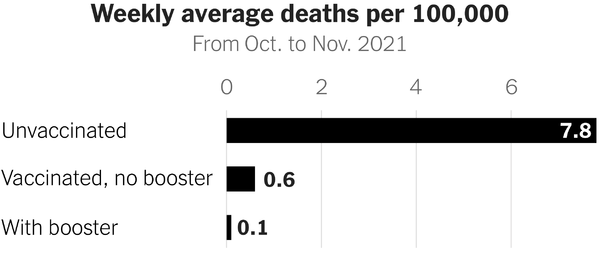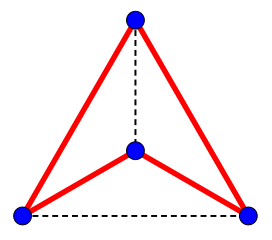- This session will be captured on Zoom, if
I remember to turn it on, and record it. Please help me to remember.
I've added "boardwork" to our a page of the zooms and the play-by-plays. I noticed that it's awfully hard to see, using the standard camera view in Zoom. I'll see if we can capture that better....
- Roll
- You have an assignment for next time.
- You had an assignment (to illustrate our Tree Terminology page
with your very own, beautiful illustrations!). My other section
was expected to illustrate the graphs.
I'll need more time to collect the greatest hits (next time).
- Your first IMath homework is due this Friday.
- We finished off our "Covid unit" by building some trees to help
us calculate some probabilities, and some "relative risks"
(e.g., in New South Wales, Australia, those unvaccinated were 25-26
times more likely to suffer a severe outcome (ICU or death).
This morning's graphic, from the NYTimes, focused on the value of the booster, in particular:

These are "deaths per 100K" (same denominators); so in this time period, those unvaccinated were 78 times more likely to die than those who'd been vaxxed and boosted.
The risk of death for those vaxxed, but unboosted, was five times greater than those fully protected.
-
I want to show off one more tool for calculating these
probabilities, and show that our results were meaningful. Let's
look at the breast cancer study again.
For these tests, it's important to understand the terminology (especially the sensitivity and specificity).
The fellow who created this test suggests that a better way to think of tests is in terms of the "miss rate" (those with the disease who are missed by the test), and the "false positive rate".
These are the flip sides of sensitivity and specificity (terms which seem a little mysterious -- or non-intuitive): if the
- sensitivity is 90%, the miss rate is 10%;
- specificity is 95%, the false positive rate is 5%.
And, as we discussed last week, all errors are not created equal:
- in the case of breast cancer, the false positive rate is the chance we scare the heck out of someone for no good reason, and perhaps send them for more testing, biopsies, etc., even though they don't need them;
- the miss rate is much worse: we've got a patient with breast cancer who doesn't know they have it, and so aren't being treated while the disease progresses.
(Hmmm, seems like this one should be pretty easy.... Half a dozen?:)
- We feel like we're familiar with lots of different kinds of
numbers, but now let's talk a bit about the concept of "number"
itself. For that, one turns naturally to Sesame Street!
I asked you to do the reading "From Fish to Infinity" for today, in which we learn the answer to one of life's persistent questions: What is "six"?
We learn something of that, anyway -- at least about six fish. But
"Six is more ethereal than six fish.... It applies to six of anything..., the ineffable1 thing they all have in common." (Joy of X, p. 4) - There is an interesting philosophical question posed by the
author: "Where exactly do numbers come from?"
- "Did humanity invent them?"
- "Or discover them?"
- Strogatz suggests that "...numbers are shortcuts for counting by ones...." (p. 5)
So we might say that "six is a shortcut for counting by ones -- six times?"
(You know that you're not supposed to use the thing you're defining in the definition!)
Furthermore, "...Humphrey might realize he can keep counting forever." (p. 5) -- something that will be very important when we come to talk about infinity.
- The key concept between the idea of number is the idea of
"one-to-one correspondence": we can think of it as perfect
matching.
The French defined the meter as one ten-millionth of the distance between the equator and the north pole on a great circle passing through Paris (makes perfect sense to me....:). So the government put official "meter sticks" around the city, so that anyone could check their measures (e.g. a piece of cloth) with this "official" meter.
In Paris there is still one of the "sticks" (it's marble!) "standing" (well, actually it's along a wall at a bus stop in Paris):

So should we create marble statues of six fingers being held up, with a sign saying "six"?
Perfect matching: we will indicate the number six with something that yells "Six" to everyone. You can bring up "six" candy bars, to see if you really have six -- by matching them to fingers of marble....
- Did you notice Humphrey using any other cues to help him keep
track of the number of fish?
- How would things have changed had there been
- 20 penguins?
- 60 penguins?
- 13 penguins?
These vocal cues leads us to your upcoming reading: Rock Groups, and The Loneliest Numbers (and the first of our great factorizations: into prime numbers).
- These counting numbers also rely on order. It is said that
- One is the loneliest number, but that
- Two can be as bad as one; it's the loneliest number since the number one.
Other numbers seem very gregarious; they play well with other numbers (e.g. 6, which seems particular friendly with 2 and 3).
But how can we understand "6" without understanding "5" as well? (and thus 4, 3, 2, 1,...0?) We'll discover that 0 was pretty hard to understand from early on!
-
Maybe this is a way to make that explicit:
Each number, considered as a complete graph, encompasses all the numbers that go before it. For example, the tetrahedron is actually the complete graph with four vertices:

- Do you see the complete graph with three vertices inside of it?
- Do you see the complete graph with two vertices inside of it?
- Do you see the complete graph with one vertex inside of it?
- Last time:
-
Testing Wisely: use the numbers from our examples and you should see our results pop out:
- Plant problem:
- "disease prevalence" ("clinical probability" of water forgotten): 30%
- sensitivity (death given forgotten) = 90%
- specificity (alive given watered) = 80%
- Breast cancer problem (problem: only 100 in the cohort on this tool
-- that is a bit of a problem, but you'll see the "ghost" of
our solution!):
- disease prevalence ("clinical probability"): 0.8%
- sensitivity (test positive given breast cancer): 90%
- specificity (test negative given no breast cancer): 93%
- Covid problem (problem: only 100 in the cohort on this
tool, rather than the 1000 we considered):
- disease prevalence ("clinical probability"): 2%
- sensitivity (test positive given covid positive): 70%
- specificity (test negative given covid negative): 95%
Or would "miss rate" and "false positive rate" be better terms to use than "sensitivity" & "specificity"?
- Plant problem:
- Let's hear from a doctor: "As a doctor I'm so happy you're using
your platform to get this information out. Let me tell you though... it
gets way more complicated! Unfortunately prevalence estimates aren't
always known and are constantly changing (especially in
pandemics). Another thing to consider is the gold standard. If your
test looks for breast cancer you can cut out the lump and look at it
under a microscope. Some diseases aren't as easily clarified. For
instance, since we don't have a highly accurate, easy test for
pancreatic cancer we rely on imaging, demographics, blood markers,
symptoms (or lack thereof) as multiple things that form a conglomerate
test to increase our Bayes factor. Despite all these things we can't
always get a great prediction on whether that scar in your bile duct is
cancer or just a residual scar from pancreatitis you had 10 years
ago. So we offer the patient a huge surgery to remove the head of their
pancreas and duodenum only to find that it wasn't cancer. You can
imagine the patient is happy it's not cancer but not so happy they
don't have half their pancreas and have abdominal pain and maybe
diabetes. Medicine is a tricky thing. Another tricky thing is operator
error. Some tests depend on the skill of the lab tech, radiologist, or
surgeon. The complexity of the human body and the uniqueness of each
individual also plays a role. Your test may be false positive in a
particular patient 100% of the time because they have some strange
protein mutation. It's tough!" ("nixcasts", from a comment on the video
The medical test
paradox, and redesigning Bayes' rule)
-
- Today: